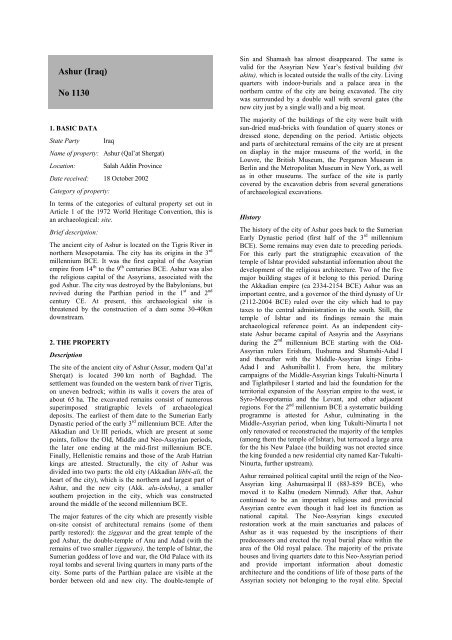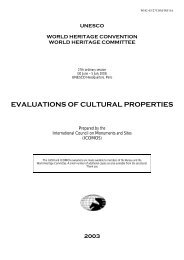evaluations of cultural properties - UNESCO: World Heritage
evaluations of cultural properties - UNESCO: World Heritage
evaluations of cultural properties - UNESCO: World Heritage
You also want an ePaper? Increase the reach of your titles
YUMPU automatically turns print PDFs into web optimized ePapers that Google loves.
Ashur (Iraq)<br />
No 1130<br />
1. BASIC DATA<br />
State Party Iraq<br />
Name <strong>of</strong> property: Ashur (Qal’at Shergat)<br />
Location: Salah Addin Province<br />
Date received: 18 October 2002<br />
Category <strong>of</strong> property:<br />
In terms <strong>of</strong> the categories <strong>of</strong> <strong>cultural</strong> property set out in<br />
Article 1 <strong>of</strong> the 1972 <strong>World</strong> <strong>Heritage</strong> Convention, this is<br />
an archaeological: site.<br />
Brief description:<br />
The ancient city <strong>of</strong> Ashur is located on the Tigris River in<br />
northern Mesopotamia. The city has its origins in the 3 rd<br />
millennium BCE. It was the first capital <strong>of</strong> the Assyrian<br />
empire from 14 th to the 9 th centuries BCE. Ashur was also<br />
the religious capital <strong>of</strong> the Assyrians, associated with the<br />
god Ashur. The city was destroyed by the Babylonians, but<br />
revived during the Parthian period in the 1 st and 2 nd<br />
century CE. At present, this archaeological site is<br />
threatened by the construction <strong>of</strong> a dam some 30-40km<br />
downstream.<br />
2. THE PROPERTY<br />
Description<br />
The site <strong>of</strong> the ancient city <strong>of</strong> Ashur (Assur, modern Qal’at<br />
Sherqat) is located 390 km north <strong>of</strong> Baghdad. The<br />
settlement was founded on the western bank <strong>of</strong> river Tigris,<br />
on uneven bedrock; within its walls it covers the area <strong>of</strong><br />
about 65 ha. The excavated remains consist <strong>of</strong> numerous<br />
superimposed stratigraphic levels <strong>of</strong> archaeological<br />
deposits. The earliest <strong>of</strong> them date to the Sumerian Early<br />
Dynastic period <strong>of</strong> the early 3 rd millennium BCE. After the<br />
Akkadian and Ur III periods, which are present at some<br />
points, follow the Old, Middle and Neo-Assyrian periods,<br />
the later one ending at the mid-first millennium BCE.<br />
Finally, Hellenistic remains and those <strong>of</strong> the Arab Hatrian<br />
kings are attested. Structurally, the city <strong>of</strong> Ashur was<br />
divided into two parts: the old city (Akkadian libbi-ali, the<br />
heart <strong>of</strong> the city), which is the northern and largest part <strong>of</strong><br />
Ashur, and the new city (Akk. alu-ishshu), a smaller<br />
southern projection in the city, which was constructed<br />
around the middle <strong>of</strong> the second millennium BCE.<br />
The major features <strong>of</strong> the city which are presently visible<br />
on-site consist <strong>of</strong> architectural remains (some <strong>of</strong> them<br />
partly restored): the ziggurat and the great temple <strong>of</strong> the<br />
god Ashur, the double-temple <strong>of</strong> Anu and Adad (with the<br />
remains <strong>of</strong> two smaller ziggurats), the temple <strong>of</strong> Ishtar, the<br />
Sumerian goddess <strong>of</strong> love and war, the Old Palace with its<br />
royal tombs and several living quarters in many parts <strong>of</strong> the<br />
city. Some parts <strong>of</strong> the Parthian palace are visible at the<br />
border between old and new city. The double-temple <strong>of</strong><br />
Sin and Shamash has almost disappeared. The same is<br />
valid for the Assyrian New Year’s festival building (bit<br />
akitu), which is located outside the walls <strong>of</strong> the city. Living<br />
quarters with indoor-burials and a palace area in the<br />
northern centre <strong>of</strong> the city are being excavated. The city<br />
was surrounded by a double wall with several gates (the<br />
new city just by a single wall) and a big moat.<br />
The majority <strong>of</strong> the buildings <strong>of</strong> the city were built with<br />
sun-dried mud-bricks with foundation <strong>of</strong> quarry stones or<br />
dressed stone, depending on the period. Artistic objects<br />
and parts <strong>of</strong> architectural remains <strong>of</strong> the city are at present<br />
on display in the major museums <strong>of</strong> the world, in the<br />
Louvre, the British Museum, the Pergamon Museum in<br />
Berlin and the Metropolitan Museum in New York, as well<br />
as in other museums. The surface <strong>of</strong> the site is partly<br />
covered by the excavation debris from several generations<br />
<strong>of</strong> archaeological excavations.<br />
History<br />
The history <strong>of</strong> the city <strong>of</strong> Ashur goes back to the Sumerian<br />
Early Dynastic period (first half <strong>of</strong> the 3 rd millennium<br />
BCE). Some remains may even date to preceding periods.<br />
For this early part the stratigraphic excavation <strong>of</strong> the<br />
temple <strong>of</strong> Ishtar provided substantial information about the<br />
development <strong>of</strong> the religious architecture. Two <strong>of</strong> the five<br />
major building stages <strong>of</strong> it belong to this period. During<br />
the Akkadian empire (ca 2334-2154 BCE) Ashur was an<br />
important centre, and a governor <strong>of</strong> the third dynasty <strong>of</strong> Ur<br />
(2112-2004 BCE) ruled over the city which had to pay<br />
taxes to the central administration in the south. Still, the<br />
temple <strong>of</strong> Ishtar and its findings remain the main<br />
archaeological reference point. As an independent citystate<br />
Ashur became capital <strong>of</strong> Assyria and the Assyrians<br />
during the 2 nd millennium BCE starting with the Old-<br />
Assyrian rulers Erishum, Ilushuma and Shamshi-Adad I<br />
and thereafter with the Middle-Assyrian kings Eriba-<br />
Adad I and Ashuniballit I. From here, the military<br />
campaigns <strong>of</strong> the Middle-Assyrian kings Tukulti-Ninurta I<br />
and Tiglathpileser I started and laid the foundation for the<br />
territorial expansion <strong>of</strong> the Assyrian empire to the west, ie<br />
Syro-Mesopotamia and the Levant, and other adjacent<br />
regions. For the 2 nd millennium BCE a systematic building<br />
programme is attested for Ashur, culminating in the<br />
Middle-Assyrian period, when king Tukulti-Ninurta I not<br />
only renovated or reconstructed the majority <strong>of</strong> the temples<br />
(among them the temple <strong>of</strong> Ishtar), but terraced a large area<br />
for the his New Palace (the building was not erected since<br />
the king founded a new residential city named Kar-Tukulti-<br />
Ninurta, further upstream).<br />
Ashur remained political capital until the reign <strong>of</strong> the Neo-<br />
Assyrian king Ashurnasirpal II (883-859 BCE), who<br />
moved it to Kalhu (modern Nimrud). After that, Ashur<br />
continued to be an important religious and provincial<br />
Assyrian centre even though it had lost its function as<br />
national capital. The Neo-Assyrian kings executed<br />
restoration work at the main sanctuaries and palaces <strong>of</strong><br />
Ashur as it was requested by the inscriptions <strong>of</strong> their<br />
predecessors and erected the royal burial place within the<br />
area <strong>of</strong> the Old royal palace. The majority <strong>of</strong> the private<br />
houses and living quarters date to this Neo-Assyrian period<br />
and provide important information about domestic<br />
architecture and the conditions <strong>of</strong> life <strong>of</strong> those parts <strong>of</strong> the<br />
Assyrian society not belonging to the royal elite. Special






